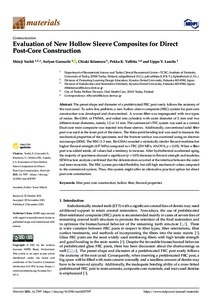Evaluation of New Hollow Sleeve Composites for Direct Post-core Construction
Yoshii Shinji; Garoushi Sufyan; Kitamura Ciaki; Vallittu Pekka K; Lassila Lippo V.
https://urn.fi/URN:NBN:fi-fe2021120859673
Tiivistelmä
The preset shape and diameter of a prefabricated FRC post rarely follows the anatomy of the root canal. To solve this problem, a new hollow sleeve composite (HSC) system for post-core construction was developed and characterized. A woven fiber was impregnated with two types of resins: Bis-GMA or PMMA, and rolled into cylinders with outer diameter of 2 mm and two different inner diameters, namely 1.2 or 1.5 mm. The commercial i-TFC system was used as a control. Dual-cure resin composite was injected into these sleeves. Additionally, conventional solid fiber post was used as the inner part of the sleeve. The three-point bending test was used to measure the mechanical properties of the specimens and the fracture surface was examined using an electron microscope (SEM). The HSC (1.5 mm, Bis-GMA) revealed a statistically similar flexural modulus but higher flexural strength (437 MPa) compared to i-TFC (239 MPa; ANOVA, p < 0.05). When a fiber post was added inside, all values had a tendency to increase. After hydrothermal accelerated aging, the majority of specimens showed a significant (p < 0.05) decrease in flexural strength and modulus. SEM fracture analysis confirmed that the delamination occurred at the interface between the outer and inner materials. The HSC system provided flexibility but still high mechanical values compared to the commercial system. Thus, this system might offer an alternative practical option for direct post-core construction.
Kokoelmat
- Rinnakkaistallenteet [27094]
